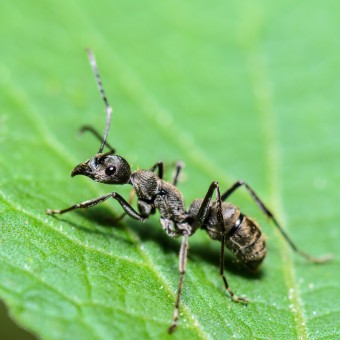The Remarkable Lancet Liver Fluke
 Making zombies of ants, Swiss cheese of snails and Sherpas of sheep and cows, the lancet liver fluke proves that you don’t need to be big to be powerful.
Making zombies of ants, Swiss cheese of snails and Sherpas of sheep and cows, the lancet liver fluke proves that you don’t need to be big to be powerful.
Growing up to 10 mm by 2.5 mm (0.5 x 0.1 inches), Dicrocoelium dendriticum is a parasitic flatworm (also known as a trematode) that begins life as eggs living in the poop of (generally) cows or sheep. Shortly after being deposited, the eggs are ingested by a snail (such as Zebrina spp. or Cionella spp.) where they hatch into larva (miracidia). In this form they burrow through the snail’s gut and rest in its connective tissue where they develop into a second larval stage (sporocysts). Now they move to the digestive gland where they bear female sporocysts, that themselves produce yet another larval stage (cercariae). These last travel to the snail’s respiration chamber from which the snail finally rids itself of the parasite when it exits as a slime ball.
As appetizing as that sounds, it’s no wonder that an ant (such as Formica fusca) will soon wander by and eat it. Once in the ant’s intestine, the cercariae are released from the ball and most migrate to the ant’s main body cavity (hemocoel) where they transform into a fourth larval stage (metacercariae).
However, one evil genius metacercaria does not join its siblings in the ant’s hemocoel, but rather travels to a cluster of nerve cells (sub-esophageal ganglion), where it “takes control of the ant’s actions by manipulating these nerves.” When night falls, the metacercaria then directs the ant to climb to the top of a blade of grass, where it stays until the morning; the ant will repeat this nightly ritual (at the behest of its puppet master) until it is eaten by a grazing animal.
The fluke has now reached the body where it will finally mature (called the primary or definitive host). It makes its way from the animal’s small intestine to its bile duct, where it reproduces and makes eggs, the latter of which are pooped by the animal into the field to start the cycle all over again.
D. dendriticum is found throughout the world and although it primarily infects sheep, cows, snails and ants, it has been known to inhabit pigs, goats, alpacas and llamas. In fact, while rare, human infections are not unknown, with the flukes infesting human bile ducts. Usually those infected suffer from only mild symptoms include bloating and diarrhea, although some suffer from enlargement of the lining of the bile ducts (biliary epithelium) that, along with a growth of fibrous tissue, can cause the liver to swell (hepatomegaly) and cirrhosis. Note that human infection is extremely rare, as you might imagine given the way one would have to acquire the parasite. For instance, one documented case happened only after a man drank water that had infected ants in it.
Regardless, you have to hand it to the lancet liver fluke that, during the course of its life, commonly forces three different animals to do its bidding, and completely bends the ant to its will. As another tiny powerhouse once said, “Judge me by my size, do you? And well you should not.”
If you liked this article, you might also enjoy our new popular podcast, The BrainFood Show (iTunes, Spotify, Google Play Music, Feed), as well as:
- The Parasite That 33% of Humans Have and Is Linked to Suicide, Schizophrenia, and Brain Cancer
- The Parasite that Becomes a Usable Tongue
- The Parasitic Sacculina That Bends Its Host to Its Own Will
- Why Toenails Turn Yellow
- The Truth About Candirú Fish and Peeing in the Amazon
Bonus Facts:
- The lancet liver fluke isn’t alone in its domination over its hosts. One species of parasitic wasp, hymenoepimecis argyraphaga, glues its egg onto a host spider, Plesiometa argyra, after paralyzing it with venom. After the egg hatches, the larva bores holes into the spider’s abdomen and modifies the spider’s structure to create a saddle for itself; thereafter, while astride the saddle, the larva transforms through several stages. At some point, it injects a chemical into the spider, which directs it to spin a cocoon web, after which it dies and is eaten by the larva; later, the larvae builds an additional cocoon to the web, and together they protect the larva until it matures.
- Likewise, a hairworm, Paragordius tricuspiadatus, infection also results in certain death for the host. Most likely ingested when drinking water, the hairworm typically infects Orthoptera (read: grasshoppers and crickets). Once inside the Orthoptera‘s body, the larva grows so large that eventually the worm takes up nearly all of the space in its host, other than the head and legs. Mature at this point, the hairworm desires to procreate, but it can only do this in the water; so, it injects chemicals into the Orthoptera that force the latter to jump into water. The worm that emerges (from the butt end of its host) can be three to four times as large as the Orthoptera where it lived. Of course, the host, which even if it could’ve survived the invasion is not a water-dweller, dies.
- Cercariae
- Definitive Host
- Dicrocoelium dendriticum
- Hemocoel
- Hymenoepimecis argyraphaga
- Lancet Liver Fluke
- Lancet Liver Fluke
- Metacercariae
- Miracidium
- ParaSites
- Parasitoid Increases Survival of Its Pupae
- Sporocyst
- Suicide Grasshoppers
- Two steps to suicide in crickets harbouring hairworms
- Yoda quotes
- Zombie Ants
| Share the Knowledge! |
|




